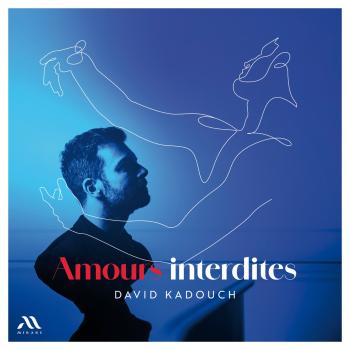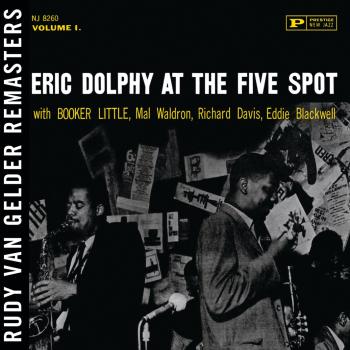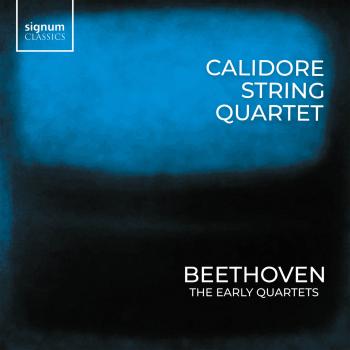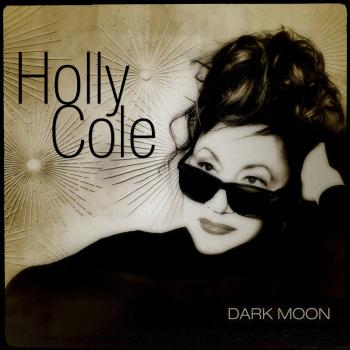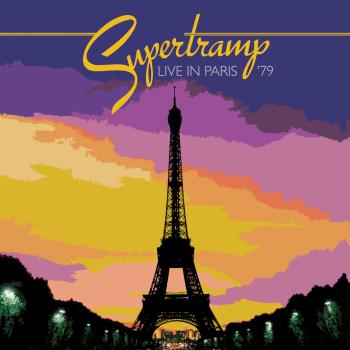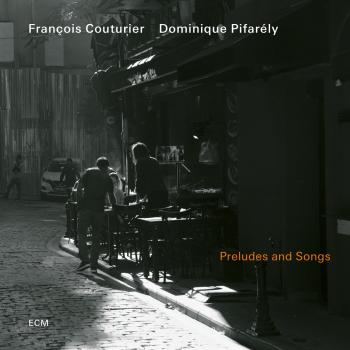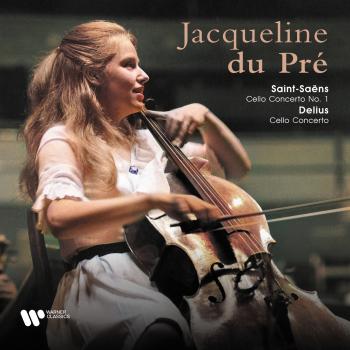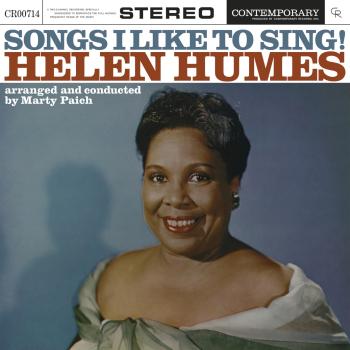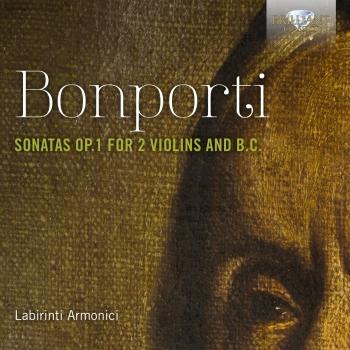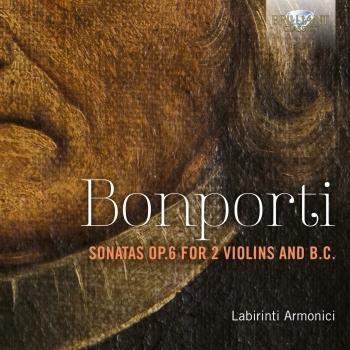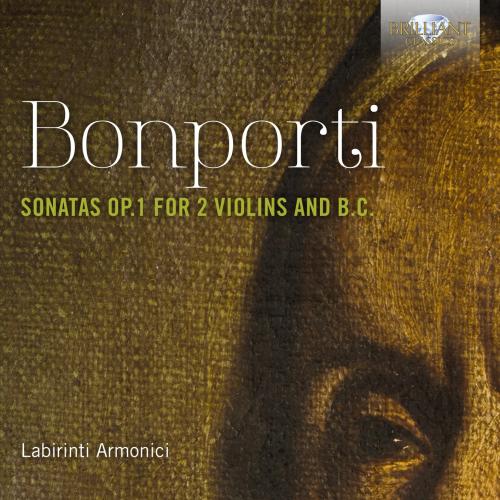
Bonporti: Sonatas, Op. 1 for 2 Violins and B.C. Labirinti Armonici
Album info
Album-Release:
2020
HRA-Release:
31.01.2020
Label: Brilliant Classics
Genre: Classical
Subgenre: Chamber Music
Artist: Labirinti Armonici
Composer: Francesco Bonporti (1672-1749)
Album including Album cover Booklet (PDF)
- Francesco Antonio Bonporti (1672 - 1749): Sonata No. 1 in D Major, Op. 1:
- 1 Sonata No. 1 in D Major, Op. 1: I. Adagio 01:30
- 2 Sonata No. 1 in D Major, Op. 1: II. Allegro 02:18
- 3 Sonata No. 1 in D Major, Op. 1: III. Grave 01:19
- 4 Sonata No. 1 in D Major, Op. 1: IV. Lento-Allegro 02:11
- Sonata No. 2 in B-Flat Major, Op. 1:
- 5 Sonata No. 2 in B-Flat Major, Op. 1: I. Adagio 01:07
- 6 Sonata No. 2 in B-Flat Major, Op. 1: II. Alla breve 01:21
- 7 Sonata No. 2 in B-Flat Major, Op. 1: III. Grave 01:40
- 8 Sonata No. 2 in B-Flat Major, Op. 1: IV. Allegro 02:17
- Sonata No. 3 in G Minor, Op. 1:
- 9 Sonata No. 3 in G Minor, Op. 1: I. Largo 01:45
- 10 Sonata No. 3 in G Minor, Op. 1: II. Allegro 02:26
- 11 Sonata No. 3 in G Minor, Op. 1: III. Grave 01:20
- 12 Sonata No. 3 in G Minor, Op. 1: IV. Con spirit 01:59
- Sonata No. 4 in B Minor, Op. 1:
- 13 Sonata No. 4 in B Minor, Op. 1: I. Grave 02:14
- 14 Sonata No. 4 in B Minor, Op. 1: II. Allegro 01:15
- 15 Sonata No. 4 in B Minor, Op. 1: III. Andante 00:58
- 16 Sonata No. 4 in B Minor, Op. 1: IV. Spiritoso 02:02
- Sonata No. 5 in D Minor, Op. 1:
- 17 Sonata No. 5 in D Minor, Op. 1: I. Andante 01:11
- 18 Sonata No. 5 in D Minor, Op. 1: II. Vivace 01:49
- 19 Sonata No. 5 in D Minor, Op. 1: III. Grave 01:45
- 20 Sonata No. 5 in D Minor, Op. 1: IV. Allegro e presto 01:50
- 21 Sonata No. 5 in D Minor, Op. 1: V. Alla breve 00:27
- Sonata No. 6 in F Major, Op. 1:
- 22 Sonata No. 6 in F Major, Op. 1: I. Largo 01:22
- 23 Sonata No. 6 in F Major, Op. 1: II. Allegro 01:06
- 24 Sonata No. 6 in F Major, Op. 1: III. Adagio 00:41
- 25 Sonata No. 6 in F Major, Op. 1: IV. Presto e allegro 01:14
- Sonata No. 7 in E Major, Op. 1:
- 26 Sonata No. 7 in E Major, Op. 1: I. Allegro 01:03
- 27 Sonata No. 7 in E Major, Op. 1: II. Allegro e puntato 01:31
- 28 Sonata No. 7 in E Major, Op. 1: III. Grave 00:57
- 29 Sonata No. 7 in E Major, Op. 1: IV. Prestissimo 01:24
- Sonata No. 8 in A Minor, Op. 1:
- 30 Sonata No. 8 in A Minor, Op. 1: I. Adagio 01:50
- 31 Sonata No. 8 in A Minor, Op. 1: II. Vivace 01:25
- 32 Sonata No. 8 in A Minor, Op. 1: III. Largo 01:17
- 33 Sonata No. 8 in A Minor, Op. 1: IV. Presto presto e unito 01:37
- Sonata No. 9 in C Major, Op. 1:
- 34 Sonata No. 9 in C Major, Op. 1: I. Vivace 00:54
- 35 Sonata No. 9 in C Major, Op. 1: II. Allegro 01:19
- 36 Sonata No. 9 in C Major, Op. 1: III. Adagio assai 02:22
- 37 Sonata No. 9 in C Major, Op. 1: IV. Presto 01:03
- Sonata No. 10 in A Major, Op. 1:
- 38 Sonata No. 10 in A Major, Op. 1: I. Spiccato 00:46
- 39 Sonata No. 10 in A Major, Op. 1: II. Tempo giusto 01:12
- 40 Sonata No. 10 in A Major, Op. 1: III. Adagio e spiccato 01:55
- 41 Sonata No. 10 in A Major, Op. 1: IV. Presto 00:58
Info for Bonporti: Sonatas, Op. 1 for 2 Violins and B.C.
Polished, historically informed accounts of little-known trio sonatas from the high noon of the Italian Baroque.
‘The playing is of a high order,’ observed Early Music World when reviewing Labirinti Armonici’s debut on Brilliant Classics (BC95718), with the Op.2 Sonatas of Francesco Antonio Bonporti: ‘the overall effect is of a highly professional group at home with the repertoire. So little of Bonporti’s works have been recorded to the highest standards; let us hope this is a start of a revival!’
Such hopes are answered here by a second disc, which returns to the set of sonatas da Chiesa which first made Bonporti’s name when they were published in 1696. Corelli, no less, is said to have instructed him in violin playing, though Bonporti regarded himself as primarily a priest rather than a composer. Indeed he used his compositions primarily as a means of preferment towards more prestigious clerical posts: writing to the secretary of the Elector of Mainz, Bonporti offered to forgo a year's salary if appointed chaplain to the emperor at Vienna.
His proposal and ambition went unrewarded on this occasion and many others, and only a century ago was his music rediscovered as part of a volume of sonatas formerly attributed to J.S. Bach. In fact the Capellmeister of Leipzig probably knew Bonporti’s music, and perhaps adopted the genre of keyboard ‘Inventions’ from him. Bonporti’s own compositional model was clearly that of Corelli, with its technically sophisticated writing for the violin, full of virtuoso touches and flourishes as well as imaginative harmony and lively part-writing. Nevertheless, his output remains under-explored even by modern ensembles, which makes this new recording an attractive acquisition for all devotees of the Italian Baroque.
Francesco Bonporti (1672-1749) lived for the largest part of his life in Trento, his native town. He studied in Rome, and was influenced by Arcangelo Corelli, whose style of imitative counterpoint he invests with dramatic elements. His fame spread over Europe and the great Johann Sebastian Bach transcribed for harpsichord some of his violin sonatas.
The complete Trio Sonatas for 2 Violins & B.C. Op. 1 consist of the 4 movements of the Sonata di Chiesa (Church Sonatas). The first violin is mainly predominant, the other two instruments usually providing the accompaniment. The faster movements require virtuoso skills from the performers while the slow movements flow in sensitive and slightly melancholy melodic lines.
The Italian group Labirinti Armonici specializes in the performance of undiscovered Baroque music, it consists of two violins, cello and harpsichord/organ. They successfully recorded the Bonporti Sonatas Op. 2 for Brilliant Classics.
Labirinti Armonici
Associazione Labirinti Armonici
came into being in 2006 with the aim of promoting familiarity with a certain type of “good music”. The main focus is baroque music, in other words compositions dating from the period 1600 to 1750. But this is not all, since the association also turns its critical attention to other repertoires with a wealth of different sounds that make for highly pleasurable listening. There are no fixed ensembles, but rather groups of musicians whose number and makeup change and evolve in the course or time.
Study of the chosen compositions is underpinned by an overall approach that is closely linked to the style of the period. The use of original early instruments fitted with gut strings, of baroque and classical bows that differ considerably from their modern equivalents, and the study of myriad extant sources in the shape of treatises
and handbooks on interpretation allow us to get very close to the taste and feelings expressed in the music of different ages. Moreover, then as today, there are questions of flair and improvisation that make every performance unique and special. Even programmes involving more recent music call for particular attention to the score, with what it reveals of the composer’s original intent and requirements.
Since 2010 the association has been organizing master classes on early music, inviting expert musicians from all over the world to come and share their knowledge and feeling for the repertoire in question. In autumn 2012 the first Temporum miracula concert season got under way with a series of events aimed at investing the group’s research and studies with continuity. Since 2015 the group has adopted the name BAROCKO. For Barocko17 the
musicians were led in a master concert by the internationally acclaimed violist Stefano Marcocchi.
Booklet for Bonporti: Sonatas, Op. 1 for 2 Violins and B.C.

